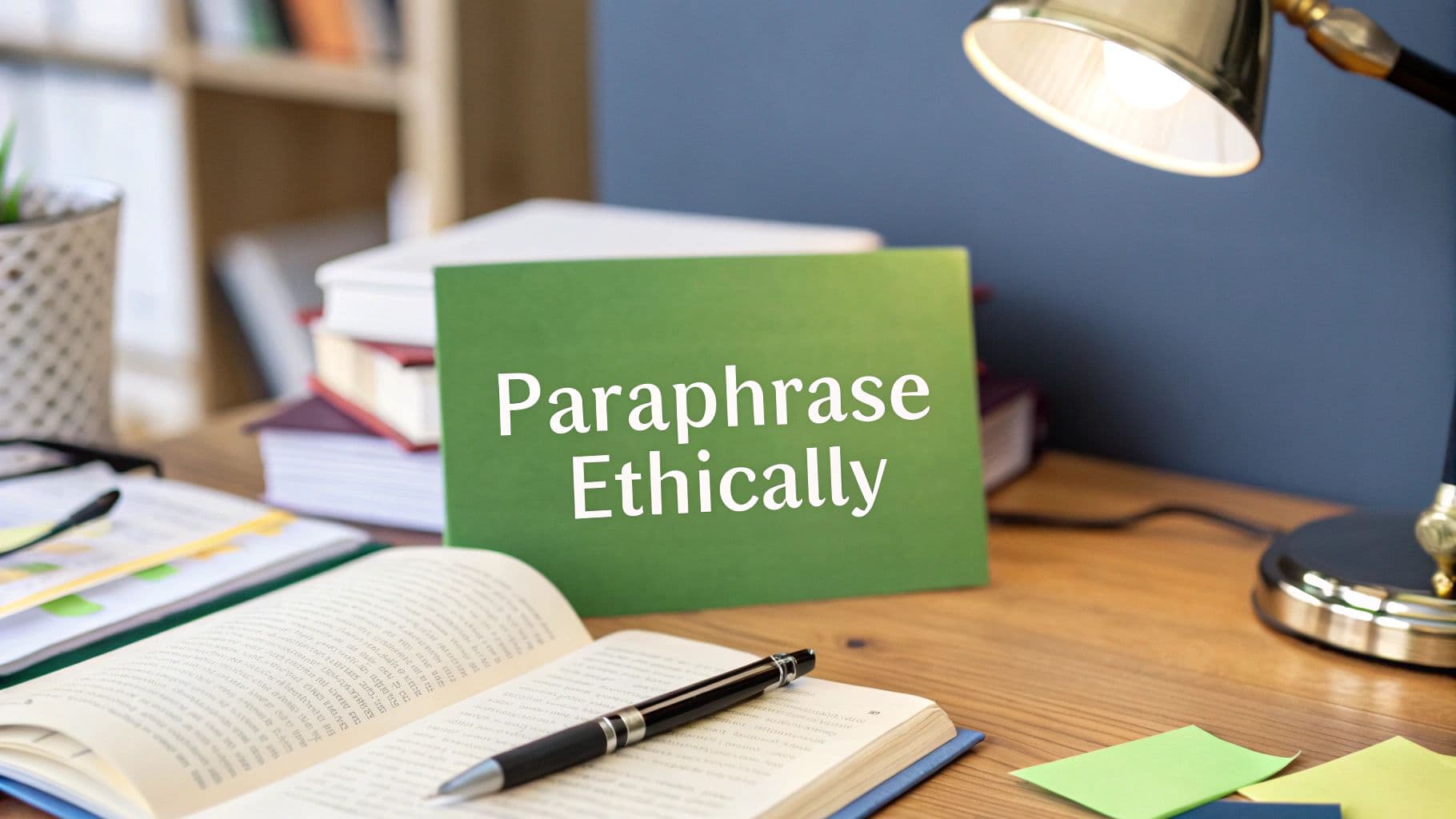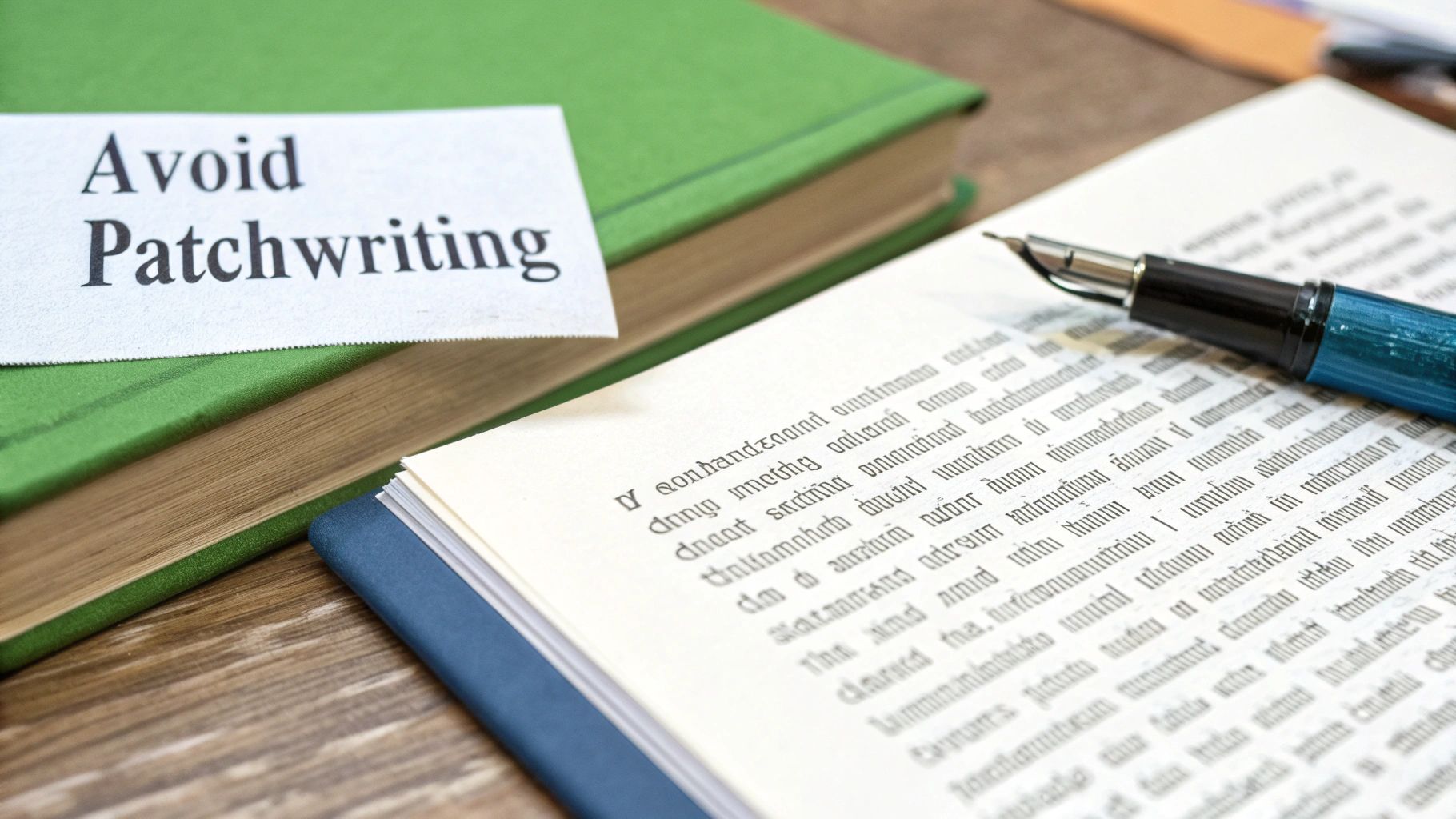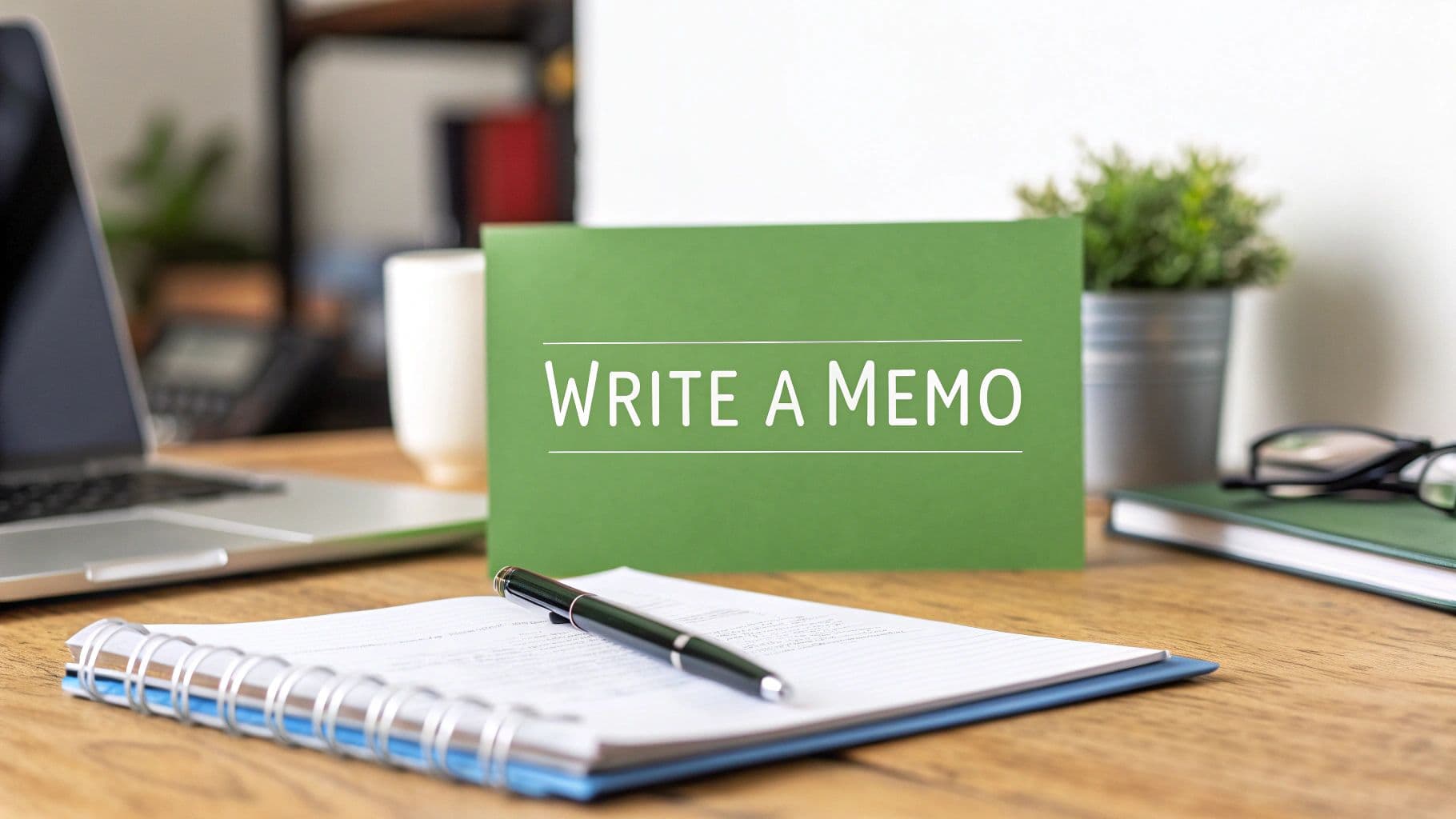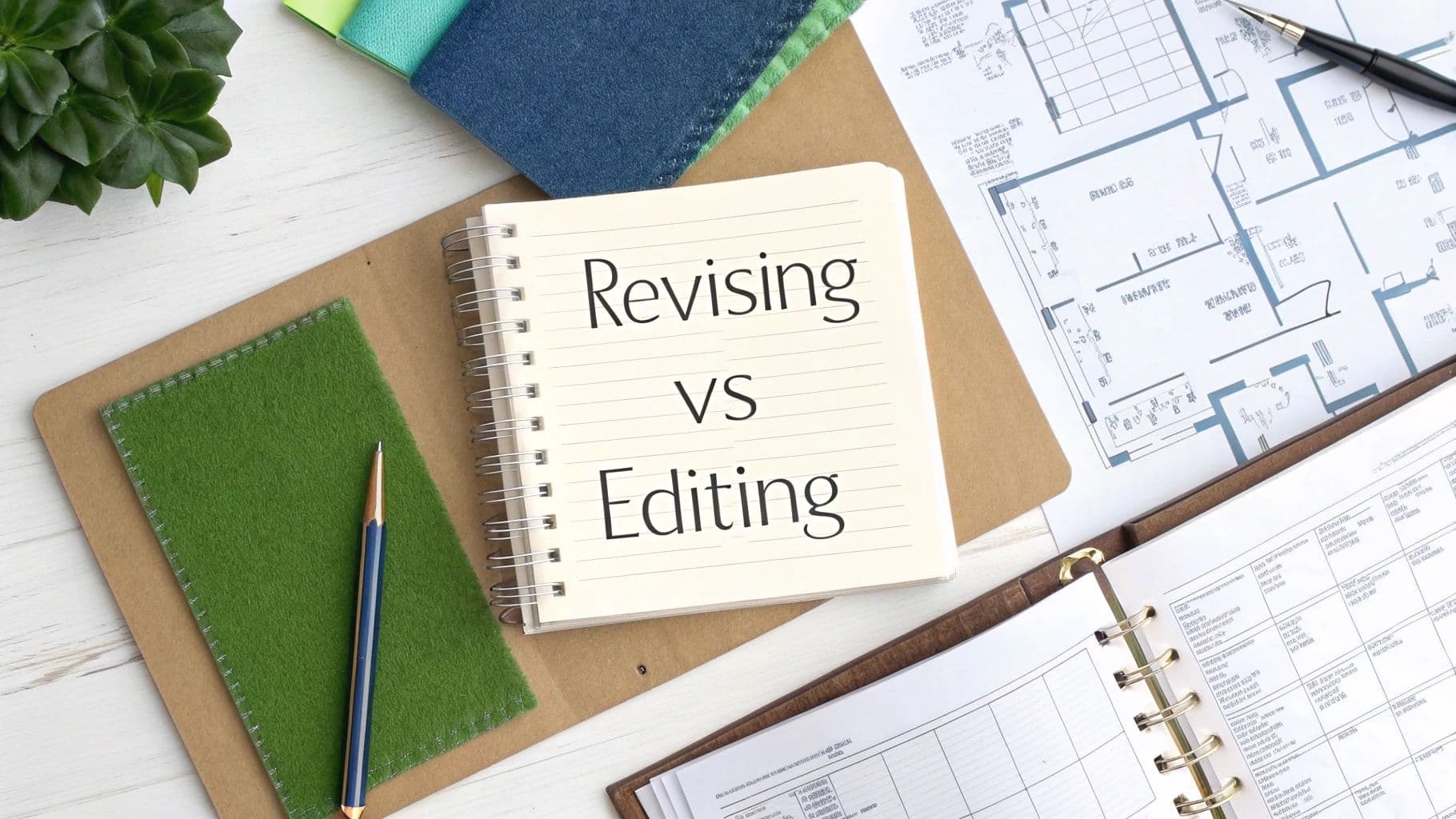
How to Paraphrase Without Plagiarizing
November 7, 2025
To paraphrase something properly, you have to do more than just swap out a few words. It's about completely rewriting the original idea in your own words and sentence structure, and then—this is the crucial part—always crediting the source.
You're essentially digesting the information so thoroughly that you can explain it in your own unique voice without leaning on the original text's framework.
What Separates Paraphrasing from Plagiarism
The line between ethical paraphrasing and plagiarism can feel a bit blurry, but the distinction is actually quite clear once you know what to look for.
Plagiarism often happens through a lazy shortcut known as "patchwriting." This is where someone takes the original sentence, keeps the structure mostly intact, and just substitutes a few words with synonyms. It's a low-effort approach that fails to show any original thought and is incredibly easy for plagiarism checkers to spot.
Think of it this way: effective paraphrasing is an active skill of comprehension and expression. Patchwriting is just rearranging someone else's furniture.
Understanding the Difference in Practice
Let's walk through a real-world example. Imagine you're researching the growing demand for plagiarism detection tools.
Original Text:
"The global plagiarism detection software market, which directly relates to the challenge of paraphrasing without plagiarizing, was valued at approximately USD 1.2 billion in 2024 and is projected to reach USD 2.8 billion by 2033. This significant growth underscores the increasing demand for sophisticated tools that help institutions uphold academic integrity by accurately identifying unauthorized copying and paraphrasing."
Now, let's look at two different ways someone might try to use this information.
Plagiarism Example (Patchwriting):
The worldwide market for plagiarism checker software, which connects to the difficulty of paraphrasing without copying, was worth about $1.2 billion in 2024 and is estimated to hit $2.8 billion by 2033. This large increase highlights the growing need for advanced tools that assist schools in maintaining academic honesty by correctly finding unapproved copying.
This version is way too close for comfort. It mimics the original sentence structure almost exactly and just swaps words like "global" for "worldwide" and "underscores" for "highlights." It's a textbook case of patchwriting and a huge red flag.
For a deeper dive into what counts as plagiarism, check out our complete guide on how to avoid plagiarism in your writing.
Effective Paraphrasing Example:
The demand for tools that ensure academic honesty is surging. In fact, the market for plagiarism detection software is expected to more than double, growing from $1.2 billion in 2024 to a projected $2.8 billion by 2033. This trend shows just how seriously institutions are taking the fight against unauthorized copying and improper paraphrasing.
See the difference? This paraphrase works because it fundamentally restructures the information. It leads with the main idea (the surging demand), presents the statistics in a new way, and uses a completely different sentence flow.
Most importantly, it proves you've actually understood the source material. By focusing on the idea rather than the words, you can paraphrase ethically and effectively.
Paraphrasing vs. Plagiarism At a Glance
Sometimes a quick side-by-side comparison makes all the difference. This table breaks down the core distinctions between doing it right and getting it wrong.
| Attribute | Effective Paraphrasing | Plagiarism (Patchwriting) |
|---|---|---|
| Structure | Completely new sentence structure | Mimics the original structure |
| Word Choice | Uses your own natural vocabulary | Swaps words with synonyms |
| Understanding | Demonstrates deep comprehension | Shows surface-level understanding |
| Originality | Focuses on conveying the idea | Focuses on altering the words |
| Citation | Always credits the original source | Often fails to cite properly (or at all) |
Ultimately, paraphrasing is a sign of good research and critical thinking. It shows you’ve engaged with the material, not just copied it.
A Practical Method for Ethical Paraphrasing
Okay, so we've covered what not to do. Now for the good part: a reliable process you can lean on every single time you need to paraphrase something. This isn't about finding a magic shortcut. It's about building a solid habit that forces you to truly understand the material and, as a result, create something genuinely original.
The whole idea is to create some distance between you and the original text. You want to get away from the author's specific words and sentence patterns so your own voice has room to come through.
This flow chart nails the concept, showing the two paths you can take—one that leads to a sloppy, problematic paraphrase and one that produces high-quality, ethical work.

As you can see, the fork in the road is simple: Are you just rearranging the original structure, or are you absorbing the idea and building something new from the ground up?
First, Really Digest the Source Material
Read the original passage a few times. The goal isn't memorization. It’s about getting a complete grip on the meaning, the nuance, and why the author wrote it in the first place.
Keep reading until you can confidently look away from the screen and explain the core point to a friend in your own words. If you find yourself fumbling or sneaking a peek back at the text, you're not there yet. This first step is absolutely non-negotiable—it’s the foundation for everything else. You have to resist the urge to start writing right away.
Now, Put the Original Away and Write from Memory
Once you've got it, I mean really got it, physically hide the source. Close the browser tab. Flip the book over. Whatever it takes. This is a critical step because it forces your brain to recall the idea, not the author's specific words.
On a blank page or a new document, start jotting down the main points from memory. Don't stress about perfect grammar or fancy sentences. Use bullet points, sentence fragments, whatever works. This is just you capturing the essence of the information in your own shorthand. Think of it as your raw material.
Key Takeaway: Writing from memory creates a buffer between the source's language and your own. Your notes should be a reflection of your understanding, not their phrasing.
Draft Your Version Using Only Your Notes
The original source should still be out of sight. Now, take your memory-based notes and start drafting your paraphrase. This is where you focus on building clear, coherent sentences that explain the concept.
Because you aren't looking at the source, you’ll naturally fall back on your own vocabulary and sentence structure. It’s a simple but powerful way to sidestep the trap of "patchwriting"—where you just swap a few synonyms and call it a day. Instead, you're constructing your sentences from scratch, based purely on your comprehension. This is the heart of learning how to paraphrase without plagiarizing.
If you want to get more creative with your sentence construction, it's worth exploring different paraphrasing techniques to add more variety to your writing.
Finally, Compare, Refine, and Cite
Once you have a solid draft, it's time to bring the original back for a side-by-side comparison.
You're looking for a few specific things:
- Accidental Copying: Did you unintentionally use any unique words or distinct phrases from the original? It happens.
- Structural Echoes: Does your sentence flow follow the original's a little too closely?
- Meaning and Accuracy: Did you capture the author's intent faithfully, without twisting or misrepresenting it?
Make any final tweaks to ensure your version is truly yours in its expression. Then comes the final, most crucial step: add a proper citation. Even a perfectly reworded paraphrase is plagiarism if you don't credit the source of the idea. This is the one step you can never skip. It gives credit where it's due and, frankly, it makes your own work more credible.
Why Just Swapping Words Is a Trap
When most people first try to paraphrase, their first instinct is to grab a thesaurus. It seems logical, right? Just swap out a few words for synonyms, maybe shuffle the order a bit, and you’re done.
Unfortunately, this shortcut—often called "patchwriting"—is one of the fastest ways to accidentally plagiarize. It's a trap because it only changes the surface-level words while leaving the original author's core sentence structure and intellectual framework completely intact.
And here's the thing: today’s plagiarism detection software is way smarter than you might think. It’s not just looking for a copy-pasted string of text anymore.

Beyond Simple Word Matching
Modern tools are specifically designed to catch these lazy paraphrasing attempts. They analyze syntax, sentence patterns, and even the semantic meaning—the underlying idea behind the words. Simply substituting "utilize" for "use" or "significant" for "important" won't fool them for a second.
The technology has come a long way. While older systems relied on direct word-for-word matching, current tools often use deep learning to spot similarities even when the text has been heavily rephrased. If your version structurally mirrors the original, it’s going to get flagged, no matter how many synonyms you used. You can learn more about the evolution of plagiarism detection methods in this detailed study.
Key Insight: Plagiarism software isn't just looking for copied words; it's looking for a copied thought process. If you follow the original author's sentence structure, you're essentially borrowing their intellectual labor.
Ineffective vs. Effective Paraphrasing Techniques
It’s easy to fall into bad habits without realizing it. The table below breaks down the difference between the risky shortcuts and the ethical, effective approaches that actually work.
| Ineffective Technique (Plagiarism Risk) | Effective Technique (Ethical Approach) |
|---|---|
| Swapping individual words with synonyms. | Restructuring the entire sentence from scratch. |
| Keeping the original sentence structure. | Starting with a different part of the idea (e.g., the outcome). |
| Following the source's flow of ideas exactly. | Synthesizing the core concept in your own words. |
| Focusing on changing words. | Focusing on communicating the meaning. |
This highlights why truly understanding the source material is non-negotiable. You can't explain something in your own way if you haven't fully digested it first.
Let's look at a concrete example to see why this distinction is so critical.
Original Sentence:
"The company's innovative marketing strategy resulted in a substantial increase in quarterly profits."
Ineffective Paraphrase (Patchwriting):
"The business's new advertising plan produced a large growth in its quarterly earnings."
This version is a classic example of what not to do. It keeps the exact same A-causes-B structure and just swaps out keywords. It shows zero original thought and is precisely what plagiarism checkers are built to detect.
Effective Paraphrase (Genuine Rewriting):
"Quarterly profits soared after the company rolled out its fresh approach to marketing."
Now this version works. It completely rethinks the sentence. It leads with the result ("profits soared"), uses entirely different phrasing ("rolled out its fresh approach"), and conveys the core idea in a genuinely new way. It proves you've actually understood the concept, not just mimicked the sentence.
That deeper level of engagement is what makes paraphrasing both ethical and effective.
How to Use AI Paraphrasing Tools Responsibly
Let's be real. AI writing assistants are incredibly powerful, but treating them like a one-click paraphrasing machine is a recipe for disaster. If you just copy, paste, and hit "rewrite," you're going to get soulless, generic content that still has a good chance of getting flagged for plagiarism.
The trick is to stop thinking of AI as a crutch and start treating it like a smart brainstorming partner. It's not about letting the tool do the work for you; it's about using it to spark new ideas for rephrasing, which you then have to critically evaluate, rewrite, and fact-check. The final piece has to sound like you and show you actually understand the topic.
From Simple Prompts to Smart Collaboration
The quality of what you get out of an AI tool is a direct reflection of what you put in. Generic commands? You'll get generic results. It's time to move beyond the basics if you want genuinely useful and original ideas.
For instance, instead of just typing "Paraphrase this," push the AI to think differently with more specific, action-oriented prompts. Try things like:
- "Explain this concept to a beginner using an analogy."
- "Rewrite this paragraph from the perspective of a skeptic."
- "Break down these technical points into a simple bulleted list."
Prompts like these force the AI to completely re-conceptualize the information, not just swap out a few words. This gives you much more creative material to work with. You're asking it to help you see the information from a new angle, which is a core part of learning how to use ChatGPT for paraphrasing without accidentally plagiarizing.
Here’s a great example of a prompt that encourages this kind of conceptual reframing.

When you interact with AI this way, it stops being a simple rephraser and becomes a dynamic partner for exploring a topic from all sides.
Never Trust AI Output Blindly
Even with the cleverest prompts, AI tools are far from perfect. They make mistakes. They "hallucinate" facts. And they can still produce text that's way too close to the original.
One study found that AI-generated text had an average plagiarism rate of around 45%, which shows just how risky it is to trust these tools without any human oversight.
Key Takeaway: Always treat AI-generated text as a first draft. Never the final product. Your job is to be the editor, the fact-checker, and the final author who ensures the work is accurate, original, and properly cited.
This "human-in-the-loop" approach is non-negotiable for anyone learning how to paraphrase without plagiarizing. AI can suggest a path, but you're the one who has to walk it, refining and reshaping the ideas until they are undeniably your own. For a broader look at how these tools fit into the world of education, this guide on AI for teachers offers some great context for using them responsibly.
Habits That Sharpen Your Paraphrasing Skills
Great paraphrasing isn't a trick you pull out for a single assignment; it's a muscle you build over time. If you want ethical rewriting to feel second nature, you need to develop habits that strengthen your comprehension and make your writing more flexible.
Think of it like learning guitar. You don't just memorize one song. You practice scales and chords until you can play almost anything. The same idea applies here.
Read Widely and Actively
One of the best things you can do is read outside your own field. Seriously. When you dive into topics you're unfamiliar with—history, science, fiction, whatever—you expose yourself to entirely new vocabulary and sentence structures.
This constant exposure expands your mental toolkit. You start to internalize different ways of explaining things, which makes it far easier to avoid parroting an author's original phrasing. Your own writing voice gets richer and more adaptable in the process.
Try the Feynman Technique
A powerful way to make sure you actually understand something is the "explain it to a friend" method, often credited to physicist Richard Feynman. Before you even try to write, explain the concept you just read out loud. Use the simplest terms you can think of.
- Nail the Core Idea: What's the one thing the author is really trying to say?
- Use Simple Analogies: Can you connect this complex idea to something anyone would understand?
- Speak, Don't Write: Talking it out forces you to use your own natural language, not the author's.
If you find yourself stumbling or falling back on jargon, you probably haven't grasped it well enough. This is a fantastic way to internalize the information, which is the whole point of learning how to paraphrase without plagiarizing. It shifts your focus from the words on the page to the concept in your head.
Pro Tip: Try recording yourself explaining the idea on your phone. When you listen back, you'll immediately hear where your understanding is weak or where you're still leaning too heavily on the original text.
Get Organized with a Citation Manager
This might sound like an organizational tip, but it's a foundational writing habit. Get comfortable with a citation manager like Zotero, Mendeley, or EndNote from the very start of a project.
As soon as you save a source, jot down a few notes summarizing the key takeaways in your own words. This builds a habit of processing and rephrasing information on the fly, long before you start drafting.
It turns citation from a dreaded final step into an active part of your research. This tiny habit saves you from massive headaches later and ensures you always give credit where it's due.
Common Paraphrasing Questions
Even when you have a solid process, the real world throws curveballs. Learning to navigate these gray areas is what separates someone who just rewords things from someone who truly understands how to paraphrase ethically.
Let's dig into some of the most common questions that trip people up. Getting these right is key to producing great, honest work.
Do I Really Need to Cite One Small Idea?
Yes. Absolutely. If the idea isn't yours and isn't common knowledge (like the fact that the sky is blue), you have to cite it. It doesn't matter if it's a tiny statistic or a quick mention of someone else's concept.
Citing sources isn't just about avoiding plagiarism accusations. It’s about showing respect for the original author's work and, just as importantly, boosting your own credibility. A well-placed citation tells your reader you've done the work, and it adds serious weight to your argument.
How Much Do I Need to Change for It to Be a Paraphrase?
This is a classic. But there's no magic number here—no 20% rule or secret word count. The real test is whether you've fundamentally changed both the wording and the sentence structure. If your version still follows the original sentence pattern or leans on the same key phrases, you're treading into "patchwriting" territory, which is a big no-no.
Key Takeaway: Stop thinking in percentages and start thinking about comprehension. If you genuinely understand the idea, you'll naturally be able to explain it in a way that’s completely your own, both structurally and stylistically.
Your goal is to convey the core meaning in your voice, not just shuffle the original author's words around.
Can I Paraphrase My Own Previous Work?
It's a surprisingly common question, and the answer is almost always no. Reusing your own material from a previous paper or publication without citing it is known as self-plagiarism, and it's taken very seriously in academic and professional circles.
So, what's the big deal?
- Originality Is Key: Most universities and publishers expect every submission to be entirely original for that specific assignment or publication.
- Build on Your Ideas, Don't Repeat Them: If you want to refer back to something you've already established, the right way to do it is to cite your previous work just like you would any other source.
- Check the Policies: When in doubt, always look up your institution's or publisher's official policy. While they can vary, the default rule is simple: cite anything that isn't brand new for the project you're working on now.
Treating your own published research with the same respect you'd give to anyone else's is a mark of true academic integrity. It's a simple habit that keeps your work transparent and helps you build a strong, ethical body of work over time.
Ready to move beyond the fear of accidental plagiarism? Natural Write is a free platform designed to help you transform AI-generated drafts into natural, humanized writing that passes detection with ease. Refine your essays, blogs, and marketing copy with a single click, ensuring your voice shines through while maintaining originality and clarity. Try it now at https://naturalwrite.com.


